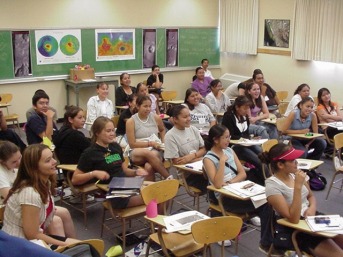Failing Consequences
Each year, a school corporation is granted an Adequate Yearly Progress (AYP) report, with either a pass or fail grade. These reports break down criteria by subject, then break down each suject into subgroups, such as ethnicity, socioeconomic being, and even intellectual placement. According to the Indiana Department of Education, only half of schools in Indiana are passing. So why do we think there are so many schools failing? How about we compare two school districts' AYP according to the Indiana Department of Education, one passing and one failing.
Logansport Community School Corporation, located in Cass County, did not meet AYP, but according to the 2008 AYP, they only did not meet standards in two areas: English - Hispanics and English - Free Lunch. West Lafayette School Corporation, a district in Tippecanoe County, met standards in all areas, and therefore passed.
According to this data, it appears that in order to pass AYP, the corporation must pass every single area that they are being graded on. However, not every place is graded on the same criteria. Whether it is able to be accounted for in the AYP is dependent on the amount of how many students they have that fit into the subcategory. If a corporation does not have enough students, then they will not be graded in that subcategory.
Logansport Community School Corporation, located in Cass County, did not meet AYP, but according to the 2008 AYP, they only did not meet standards in two areas: English - Hispanics and English - Free Lunch. West Lafayette School Corporation, a district in Tippecanoe County, met standards in all areas, and therefore passed.
According to this data, it appears that in order to pass AYP, the corporation must pass every single area that they are being graded on. However, not every place is graded on the same criteria. Whether it is able to be accounted for in the AYP is dependent on the amount of how many students they have that fit into the subcategory. If a corporation does not have enough students, then they will not be graded in that subcategory.
So, what happens to these schools that do not make AYP? The degree of the consequence depends on how many consecutive years a school has not made AYP. These schools are required to do an approved action that Indiana officials believe will help. If another year passes by and the school still fails, then they must add more actions, as well as continue with the ones already in progress. Once a school has not met AYP in five years, the school goes into Corrective Action Planning. Because of this, they MUST do at least one of the following plans of action the following year: Replace relevant school staff, sufficiently extend school day or year, hire a full-time literacy or math coach, or hire an English learner specialist (Adequate Yearly Progress). As you can see, in order to do all these actions in Corrective Action Planning, funding is needed to help pay for new staff or electricity to keep the school open longer. Not all schools can afford this sort of action, even with the additional money they are receiving.
In order to be able to pay for these new expenses, school corporations begin to pull money from their other schools. In Lafayette, Indiana, Lafayette School Corporation (LSC), is doing just that. One of their eight elementary schools, Miller Elementary, is on its fourth year of not making AYP, and another one of their schools, Murdock Elementary, is not too far behind. Because the corporation must pay for these schools' programming, they have pulled funding from their remaining elementary schools (Watling). Even though it is understandable as to why they had to do this, it puts the other six schools at an unfair disadvantage to the students they need to help out.
In order to be able to pay for these new expenses, school corporations begin to pull money from their other schools. In Lafayette, Indiana, Lafayette School Corporation (LSC), is doing just that. One of their eight elementary schools, Miller Elementary, is on its fourth year of not making AYP, and another one of their schools, Murdock Elementary, is not too far behind. Because the corporation must pay for these schools' programming, they have pulled funding from their remaining elementary schools (Watling). Even though it is understandable as to why they had to do this, it puts the other six schools at an unfair disadvantage to the students they need to help out.

